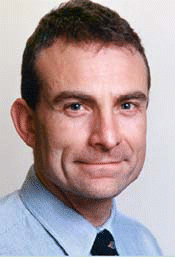Dr. Rubens hypothesizes that SIDS results from a disruption in vestibular function caused by an injury to the inner ear and brainstem during the birthing process. According to Dr. Rubens, information concerning carbon dioxide levels is transmitted via the inner ear to the brain, and therefore an inner ear injury at birth could account for the infant’s inability to respond to rising carbon dioxide levels.
Explore This Issue
April 2008What I’m proposing that is new is that carbon dioxide levels are transmitted through the inner ear and we’ve missed that, he said. Basically, as carbon dioxide rises, the SIDS baby is not getting that information to the brain because of inner ear damage, so the carbon dioxide keeps rising and they don’t realize it, and they end up in a fatal cascade.
I’m proposing that there is an injury at birth that causes damage to various organs around the body, including the inner ear and brainstem, he said. I propose that in time we will find that all SIDS babies have inner ear and brainstem damage from a birthing insult.
For Dr. Manning the theory is plausible, but he remains cautious. I think that it is plausible that hearing loss or cochlear damage might be a marker for more global ischemic damage that predisposes to SIDS, he said. However, he added, that personally, I am not sure about this idea.
Dr. Bauman is also cautious. The etiology of SIDS is so multifactorial that it is difficult to believe this finding could be a marker of susceptibility for all cases. Every time a new discovery is made that is thought to be a cause of SIDS, it probably only accounts for susceptibility in a small percentage of infants who are victims of SIDS.
According to Dr. Bauman, SIDS is a diagnosis of exclusion, and subsequently there are a number of different causes. When an infant dies of an unexplained cause, an extensive postmortem study is completed to try to determine the cause of death, she said. If a cause cannot be found in a baby between one month and one year of age, and if specific pathologic criteria are met, the diagnosis of SIDS is made. However, the postmortem investigations of suspected cases of SIDS are not always standardized between institutions and between countries so it is sometimes difficult to draw meaningful conclusions about a common etiology of the deaths.
For Dr. Bauman, who has difficulty with the theory that a trauma or injury to the inner ear and brainstem can cause SIDS, a more plausible cause of SIDS has to do with other identified risk factors, including genetic factors and exposure to tobacco smoke.

Leave a Reply